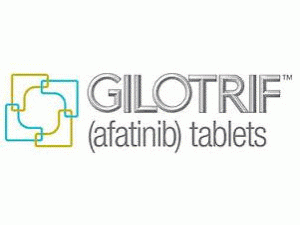阿法替尼,阿法替尼片Afatinib(Gilotrif 30mg Tablets)
 药店国别:无
产地国家:美国
处方药:是
所属类别: 30mg毫克/片 30片
包装规格: 30mg毫克/片 30片
计价单位:盒
生产厂家中文参考译名:无
生产厂家英文名:Boehringer Ingelheim Pharmaceuticals Inc.
原产地英文商品名:Gilotrif 30mg/Tablet 30Tablets/
原产地英文药品名:afatinib
中文参考商品译名:Gilotrif 30mg毫克/片 30片
中文参考药品译名:阿法替尼
曾用名:无
药店国别:无
产地国家:美国
处方药:是
所属类别: 30mg毫克/片 30片
包装规格: 30mg毫克/片 30片
计价单位:盒
生产厂家中文参考译名:无
生产厂家英文名:Boehringer Ingelheim Pharmaceuticals Inc.
原产地英文商品名:Gilotrif 30mg/Tablet 30Tablets/
原产地英文药品名:afatinib
中文参考商品译名:Gilotrif 30mg毫克/片 30片
中文参考药品译名:阿法替尼
曾用名:无
简介
近日,美国食品药品管理局(FDA)宣布,已批准将Gilotrif(阿法替尼)用于治疗在伴随诊断检测(therascreen EGFR RGQ PCR试剂盒)中发现有表皮生长因子(EGFR)外显子19删除或外显子21 L858R取代基因突变的晚期(转移性)非小细胞肺癌(NSCLC)患者。 Gilotrif是一种酪氨酸激酶抑制剂,可阻断促进癌细胞发育的蛋白质。 批准日期: 2013年7月12日 公司: Boehringer Ingelheim Pharmaceuticals Inc.GILOTRIF™ (阿法替尼[afatinib])片,为口服使用 美国初次批准:2013 作用机制 Afatinib与EGFR(ErbB1),HER2 (ErbB2),和HER4 ErbB4)的激酶结构域共价结合和不可逆地抑制酪氨酸激酶自身磷酸化,导致ErbB信号的下调。Afatinib显示自身磷酸化的抑制作用和在体外表达野生型EGFR细胞株的增殖或表达选择性EGFR外显子19缺失突变或外显子21 L858R突变,包括在患者中在可到达的afatinib浓度时,至少暂时,某些有一种次发T790M突变。 此外,在体外afatinib抑制过表达HER2细胞株的增殖。在植入肿瘤或过表达野生型 EGFR或HER2或在一种EGFR L858R/T790M双突变体模型裸鼠中用afatinib治疗导致肿瘤生长的抑制。 适应证和用途 GILOTRIF是一种激酶抑制剂适用为有转移非小细胞肺癌(NSCLC)患者一线治疗其肿瘤有当用FDA批准的测试检出的表皮生长因子受体(EGFR)外显子19缺失或外显子21(L858R)取代突变。 使用限制:尚未在肿瘤有其他EGFR突变患者中确定GILOTRIF的安全性和疗效。 剂量和给药方法 (1)推荐剂量:40mg口服,每天1次 (2)指导患者在进餐前至少1小时或后2小时服用GILOTRIF 剂型和规格片:40 mg,30 mg,和20mg 禁忌证:无 警告和注意事项 (1)腹泻:腹泻可能导致脱水和肾衰。对严重和对抗腹泻药物无反应延长腹泻不给GILOTRIF。 (2)大疱和剥脱性皮肤疾病:0.15%患者中生严重大疱,起泡,和去角质病变。对威胁生命的皮肤反应终止药物。对严重和延长皮肤反应不给GILOTRIF。 (3)间质性肺病(ILD):在1.5%患者发生。对肺症状急性发作或恶化不给GILOTRIF。如被诊断ILD终止 GILOTRIF。 (4)肝毒性:在0.18%患者中发生致命性肝损伤。用定期肝检验监视。对肝检验严重或恶化不给或终止 GILOTRIF。 (5)角膜炎:在0.8%患者中发生。不给GILOTRIF对角膜炎评价。对确证溃疡性角膜炎不给或终止GILOTRIF。 (6)胚胎胎儿毒性:可致胎儿危害。劝告女性对胎儿潜在危害和使用高效避孕。 不良反应 最常见不良反应(≥20%)是腹泻,皮疹/痤疮样皮炎,口腔炎,甲沟炎,干皮肤,食欲减低,瘙痒。 药物相互作用 P-gp抑制剂的共同给药可能增加afatinib暴露。如不能耐受每天减低GILOTRIF 10mg。慢性Pgp诱导剂口服的共同给药可能减低afatinib暴露。当耐受时每天增加GILOTRIF 10mg。 在特殊人群中使用哺乳母亲:终止药物或哺乳。 供应/贮存和处置 GILOTRIF片可得到如下:40 mg:浅蓝色,薄膜包衣,圆,双凸形,斜缘片在一侧凹陷有“T40”和在另一侧Boehringer Ingelheim公司符号。3 0片瓶使用单元 NDC:0597-0138-3030 mg:暗蓝色,薄膜包衣,圆,双凸形,斜缘片在一侧凹陷有“T30”和在另一侧Boehringer Ingelheim公司符号。 30片瓶使用单元 NDC:0597-0137-3020 mg:白色至淡黄色,薄膜包衣,圆,双凸形,斜缘片在一侧凹陷有“T20”和在另一侧Boehringer Ingelheim公司符号。 30片瓶使用单元 NDC:0597-0141-30贮存贮存在25°C(77°F);外出允许至15°-30°C(59°-86°F)[见USP控制室温]。发放药物在原始容器内避免暴露至高湿度和光。 国内外上市情况阿法替尼由勃林格殷格翰公司研制开发,2013年7月在美国以Gilotrif为商品名获得批准,2013年9月在欧盟以Giotrif为商品名获得批准上市Afatinib英文版说明
Tablets Now Available for Use in Treatment of NSCLCAfatinib (Gilotrif) tablets were approved by the FDA on July 15, 2013, as a first-line oral treatment for non– small cell lung cancer (NSCLC) with epidermal growth factor receptor (EGFR) mutations.1 The oral tablets became commercially available in the United States September 2.Using an FDA-approved test kit, clinicians can make an informed decision on whether to initiate afatinib based on EGFR mutations in cancer cells. The FDA approved afatinib concurrently with the therascreen EGFR RGQ PCR Kit, a companion diagnostic that helps determine if a patient’s lung cancer cells express the EGFR mutations. Although the effectiveness of afatinib has been validated in patients with NSCLC with exon 19 deletions and exon 21 (L858R) substitution mutations, efficacy and safety have not been proven with other types of EGFR mutations.Pharmacology and PharmacokineticsAfatinib, a tyrosine kinase inhibitor, reduces ErbB signaling by binding to the kinase domains of EGFR, HER2, and HER4. ErbB receptors are involved in the growth and proliferation of cancer cells.Maximum concentrations of afatinib occur 2 to 5 hours after administration. With an elimination half-life of 37 hours, steady-state plasma levels are reached within 8 days. In pharmacokinetic studies, high-fat meals and p-glycoprotein (p-gp) inhibitors increased peak concentrations of afatinib and total exposure to it. Afatinib is minimally metabolized by liver enzymes, with 88% of each dose recovered unchanged, primarily in feces.Patients with mild-to-moderate renal impairment experienced higher trough concentrations of afatinib than patients with normal renal function. Hepatic impairment did not affect exposure. No dose adjustment is required in hepatic or renal impairment, but patients with severe renal impairment (creatinine clearance <30 mL/min) and patients with Child-Pugh class C hepatic dysfunction have not received afatinib in clinical studies.Dosage and AdministrationA single, daily, oral dose of afatinib should be taken on an empty stomach ≥1 hour before or ≥2 hours after a meal, preferably at the same time each day. If a patient misses the usual administration time, the missed dose may be taken at a later time, but only if the patient separates daily doses by at least 12 hours. The usual daily dose of afatinib is 40 mg, although dose reductions may be necessary when restarting therapy after adverse events or to manage drug interactions.Clinical TrialsPatients with metastatic, nonsquamous NSCLC, enrolled in the phase III LUX-Lung 3 trial, received afatinib (230 patients) or a combination of pemetrexed and cisplatin (115 patients). Patients taking afatinib experienced a median progression-free survival of 11.1 months versus 6.9 months for patients taking pemetrexed/cisplatin (P = .001). The difference in survival was more pronounced in patients with tumors harboring exon 19 deletions and L858R EGFR mutations. Patients with those specific mutations who received afatinib experienced a median progression-free survival of 13.6 months compared with 6.9 months in the chemotherapy arm.3Diarrhea occurred in 96% of patients treated with afatinib, of which 15% was grade 3. For patients who develop prolonged grade 2 diarrhea lasting ≥48 hours, or equal to grade 3, afatinib should be withheld until diarrhea resolves to ≤ grade 1 and resumed with appropriate dose reduction.In addition to diarrhea, the most common grade 3 drug-related adverse events observed in the afatinib treatment arm were rash (16%) and inflammation of the nail bed (paronychia) (11%). The most common drug-related grade 3 adverse events observed in the pemetrexed/cisplatin arm were neutropenia (15%), fatigue (13%), and leucopenia (8%). There was a low discontinuation rate associated with treatment-related adverse events in the trial (8% discontinuation rate for afatinib; 12% for chemotherapy).Warnings and PrecautionsP-gp inhibitors such as ritonavir, cyclosporine, ketoconazole, itraconazole, erythromycin, verapamil, tacrolimus, and amiodarone may increase exposure to afatinib. Likewise, p-gp inducers such as rifampin, carbamazepine, phenytoin, phenobarbital, and St. John’s wort may reduce exposure to afatinib. Concomitant use of a p-gp inhibitor requires a 10-mg afatinib dose reduction. If the p-gp inhibitor is discontinued, the usual dose of afatinib may be restored after 2 to 3 days without the p-gp inhibitor.2 Afatinib is a pregnancy category D medication. Animal studies show an increased risk of fetal death, reduced fetal weight, and skeletal, vascular, and dermal abnormalities. 2用药温馨提示:当您服用此药物时,需定期接受医疗专业人士的检查,以便随时针对其药效、副作用等情况进行监测。本网站所包含的信息旨在为患者提供帮助,不能代替医学建议和治疗。
药品价格查询,专业药品查询网站,药品说明书查询,药品比价 » 阿法替尼,阿法替尼片Afatinib(Gilotrif 30mg Tablets)
药品价格查询,专业药品查询网站,药品说明书查询,药品比价 » 阿法替尼,阿法替尼片Afatinib(Gilotrif 30mg Tablets)





